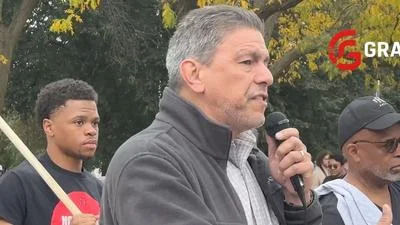Chicago CityMayor's Office issued the following announcement on May 25.
Mayor Rahm Emanuel and Chicago Police Department (CPD) Superintendent Eddie Johnson today announced the completion of installing CPD's smart policing strategy in Chicago's most challenged districts that began last year, with the launch of the latest nerve center in the 2nd (Wentworth) District on the South Side.
“As we head into the summer, it is a time to focus on the safety and security of our city,” said Mayor Emanuel. “We are not just adding more police and technology resources, but we are also adding more prevention resources. You cannot talk about one without the other.”
The smart policing strategy now covers over half the city, including 13 completed district nerve centers and100 square miles covered with gunshot detection. The district-based nerve centers house an unprecedented collaboration between civilian analysts from the University of Chicago Crime Lab who provide data and analysis, police officers who use that information to make critical deployment decisions most effective strategies in real time, and County, state and federal law enforcement officials to effectively investigate and prosecute targeted cases.
These efforts have contributed to 15 months declines in violent crime, a 32% decline in shootings citywide over 2016 and a 23% decline in murders citywide over 2016. In addition, CPD has made a 32% increase in gun arrests over 2016.
“While there still much work that remains to be done, I believe the fourteen straight months of gun violence reductions we have seen is a direct result of the investments we have made in a data driven crime strategy and in our people,” said CPD Superintendent Johnson. “Each and every day Chicago police officers in every neighborhood run bravely toward the danger to keep our streets safe. I am proud of their work and the true partnerships they are building with residents as part of our community policing philosophy.”
In addition, the Department continues to fulfill its promise to grow by nearly 1,000 officers. Today, 125 new police officers have been deployed to their district assignments. Residents of the 1st (Central), 2nd (Wentworth), 3rd (Grand Crossing), 4th (South Chicago), 6th (Gresham), 7th (Englewood), 8th (Chicago Lawn), 9th (Deering), 10th (Ogden), 11th (Harrison), 17th (Albany Park), and 18th (Near North) Districts will receive 10 new officers each. Residents of the 24th (Rogers Park) District will receive five new officers.
After successfully completing their training at the Academy in August these new officers have now completed their field training and are being sent to their first district detail. The new officers will benefit from the new in-service training requirement, which begins with 16-hours of mandatory training and will necessitate that all Department members take 40 hours of continuing education annually by 2021. These officers also benefited from a new cultural awareness course taught at the DuSable Museum of African American History, and new de-escalation, crisis intervention and procedural justice modules.
During 2017, CPD implemented smart policing strategies in six police districts on the south and west sides where gun violence presented the greatest challenge for decades - 6th (Gresham), 7th (Englewood), 9th (Deering), 10th (Ogden), 11th (Harrison), and 15th (Austin). In January 2018, this technology was expanded to the 3rd (Grand Crossing) and 4th (South Chicago) Districts, in February to the 5th (Calumet) District, in March to the 12th (Near West) District, and in April to the 8th (Chicago Lawn) and 25th (Grand Central) Districts.
In the 2nd (Wentworth) District, a station-based nerve center has been installed, as well as additional POD crime cameras and gunshot detection systems to support police in preventing, combating and responding to violent crime.
Gunshot Detection and POD Crime Cameras Expansion
The City has installed gunshot detection systems to cover the entire 2nd (Wentworth) District on the city's South Side, as well as increase the number of crime cameras. The crime camera footprint will be increased to allow for better integration between the two technologies.
Gunshot detection deployed by CPD uses electronic monitoring to detect gunshots. It detects the fullest range of gunfire, collects data that helps CPD define the scope of illegal gunfire, and with this expansion now covers exponentially more geographic area. On average, the technology gives police a five-minute lead on incidents of gun violence when compared to traditional 911 calls. The real-time monitoring also serves as a force multiplier because it provides critical information for better, more timely resource allocation.
Strategic Decision Support Centers
A Strategic Decision Support Center (SDSC) has been installed in the 2nd (Wentworth) District that will utilize existing data sources within CPD, such as offender criminal history databases and past crime data. The new SDSC places all this information it into a single, usable platform to help district command staff and officers plan for patrol deployments or prepare to respond to a call for service. The new centers will each be staffed with a civilian University of Chicago data analyst who will collect and analyze data trends, and who partners with a District Intelligence Officer to coordinate the information directly with patrol units in the field.
Mobile Technology
CPD has also issued mobile phones equipped with crime analysis tools to every beat officer who responds to a service call in the 2nd (Wentworth) District. These devices give real-time access to district intelligence information to police officers in the field, helping them determine deployment strategies based on historical crime data. This mobile technology will allow for smarter, data driven patrols and significantly decreased response times to potential service calls.
Original source can be found here.






 Alerts Sign-up
Alerts Sign-up